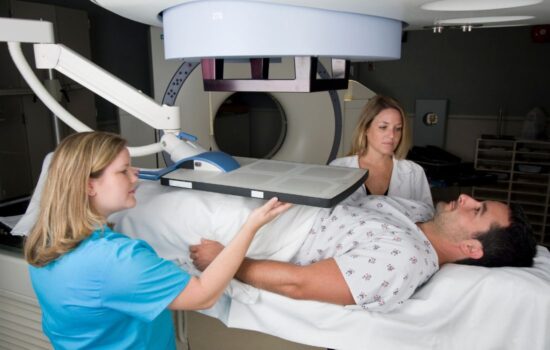August 4, 2023
Prostate Cancer Treatment Options Other than Surgery

If the results of your prostate biopsy report that you have prostate cancer, it’s time to consider your treatment options. Surgery is sometimes suggested as the “obvious” treatment. And for some men, it’s indeed a necessary part of the prostate cancer treatment process. But it is far from the only option. In fact, for many men, it’s not necessary to start treatment right away. Before making a final decision about surgery, have a look at other therapies available for prostate cancer.
Why Doesn’t Prostate Cancer Always Require Surgery?
Although a prostatectomy (prostate removal surgery) is sometimes recommended as a way to ensure that the cancer does not return after treatment, surgery is a major decision that comes with side effects that can impact your quality of life. These can include erectile dysfunction and urinary incontinence. Because there are many other prostate cancer treatment options today, including radiation therapies, hormone therapy, and targeted therapies, you may have a better outcome by not removing the entire prostate.
Determining the Best Prostate Cancer Treatment Option for You
The timing of treatment is largely based on how far the cancer had progressed by the time it was diagnosed and how likely it is to grow quickly.
Your oncologist will determine how far it’s advanced by reviewing the “Gleason score” and the grade to consider how likely it is to grow rapidly. Gleason scores show how cancer tissue differs from healthy tissue. Cells that more closely resemble healthier tissue may not need treatment at first, while more cells that appear more abnormal receive a higher Gleason score and may require treatment to begin. The slow-growing type of prostate cancer is more common.

Based on the Gleason score, the grade, and whether the nearby lymph nodes show signs of cancer, the prostate cancer stage is determined. This gives your oncologist an idea of what treatments are necessary, if any, right now.
Stages include:
Stage 1. The cancer has been found only in a limited area within the prostate.
Stage 2. The cancer has advanced within the prostate but has not yet reached any other body parts.
Stage 3. The cancer still only exists mainly on the prostate, but it is now covering more of the area than in stage 2.
Stage 4. At this stage, the cancer has spread to other body parts.
When prostate cancer is diagnosed in one of the earlier stages, it is more likely that you can avoid surgery and use an alternative treatment approach – which can include waiting before starting prostate cancer treatment.
What is Active Surveillance for Prostate Cancer?
Active surveillance involves watching the cancer closely before moving forward with treatment. This is sometimes recommended when there is a lower Gleason score and/or the treatment may be more harmful than the cancer itself.
Active surveillance requires more frequent follow-up appointments to track the cancer’s growth, but it can allow you to delay treatment and even preserve the quality of life as you move through your cancer journey. Your doctor will watch closely for rises in the PSA levels and may request a repeated biopsy. If no changes are noted, then you can continue to wait before starting any treatment. If they notice the cancer changing or growing, then they will likely recommend further testing and moving forward with treatment.

Treatment Options for Prostate Cancer Other Than Surgery
If your doctor determines that it is time to move forward with a treatment method for prostate cancer, surgery may not be in the treatment plan. There are other approaches available, and some men might not require surgery at all. Common treatment approaches for prostate cancer include hormone therapy, radiation therapy, targeted therapy, and chemotherapy.
Radiation Therapy to Treat Prostate Cancer
Radiation therapy uses high-energy particles or rays to kill cancer. Radiation therapy can be used in a variety of ways to help treat prostate cancer. It may be used as a first line of treatment, or it could be used in combination with other treatments. Sometimes, radiation is used for more severe cancer to help relieve symptoms. Types of radiation therapy that may be recommended for prostate cancer include:
External beam radiation therapy (EBRT). This type of radiation is delivered from outside the body using a machine that directs the radiation to the area of concern.
Internal radiation therapy. This form of therapy involves the internal placement of radioactive particles inside the body. Internal radiation is commonly recommended when prostate cancer is in its early stages and slow growing. This is also called brachytherapy.
Radiopharmaceuticals. Radiopharmaceuticals are a type of drug that contain radioactive components. This medication is injected into a vein, and it eventually reaches the cancer cells through the blood.
Hormone Therapy
Hormone therapy is sometimes recommended when prostate cancer has spread beyond the prostate gland to other body areas—the hormone testosterone fuels prostate cancer growth. Hormone therapy aims to stop testosterone production to halt the growth of cancer. The usual hormone therapies for prostate cancer consist of the following:
Luteinizing hormone-releasing hormone (LH-RH) agonists to halt testosterone production.
Antiandrogens that block the effects of male hormones.
Targeted Therapy for Prostate Cancer
Targeted therapy drugs are specially designed to attack cancer cells. These medications work differently than chemotherapy drugs and will have different side effects. In prostate cancer, PARP inhibitors are a targeted therapy. These inhibitors block PARP enzymes, which repair damaged DNA in cells. When the PARP pathway is blocked, cancer cells can't be repaired and eventually die off.
Chemotherapy
Chemotherapy drugs are not commonly used for prostate cancer treatment. They can be a part of the treatment plan for more advanced forms of prostate cancer that have spread beyond the prostate gland. Chemotherapy is usually used to help relieve symptoms in patients who have metastatic prostate cancer to improve their quality of life. This treatment approach may help to control cancer growth. Common chemotherapy drugs that are used for prostate cancer include docetaxel (Taxotere) and cabazitaxel (Jevtana).
Prostate Cancer Clinical Research Trials
Cancer research aims to find more effective ways to treat prostate cancer patients with better outcomes and fewer side effects. Cancer Care Centers of Brevard is able to offer clinical trial options to eligible patients at our locations in Brevard County. Your oncologist will discuss clinical trial options if you are eligible. Participation is always optional.
Check out the answers to some of our frequently asked questions about prostate cancer.
Choosing the Right Prostate Cancer Treatment For You
If you have been recently diagnosed with prostate cancer, the good news is that surgery isn't the only treatment option. Talk to an oncologist before making a decision about surgery. The prostate cancer specialists at Cancer Care Centers of Brevard consider your specific diagnosis to create a treatment plan that suits your short and long-term needs. We provide advanced treatment options and second opinions to ensure the best care for you.
Brevard County Prostate Cancer Specialists Near You
Our prostate cancer doctors are located throughout Brevard County, so you do not have to travel far to receive quality cancer care and the latest treatments. Our locations are in Melbourne, Merritt Island, Rockledge, and Palm Bay, Florida.
Categories: Prostate Cancer